【FlowDroid】一、处理流程学习
FlowDroid 一、处理流程学习
- 下载配置
- 源码概况
- 代码逻辑分析
- analyzeAPKFile
- runInfoflow
- processEntryPoint
- calculateCallbacks(sourcesAndSinks)
- 再次回到processEntryPoint
自己做一些笔记
下载配置
参照我前面的文章可以使用FlowDroid安装初体验
为了看代码了解FlowDroid如何处理,clone其官方仓库FlowDroid GitHub
源码概况
下载下来的内容还是挺多的,主要分了以下几个文件夹
- soot-infoflow: 核心功能代码
- soot-infoflowandroid: 安卓数据流分析代码
- soot-infoflow-summaries:字面意思函数摘要
- soot-infoflow-cmd:使用cmd的解释运行流程
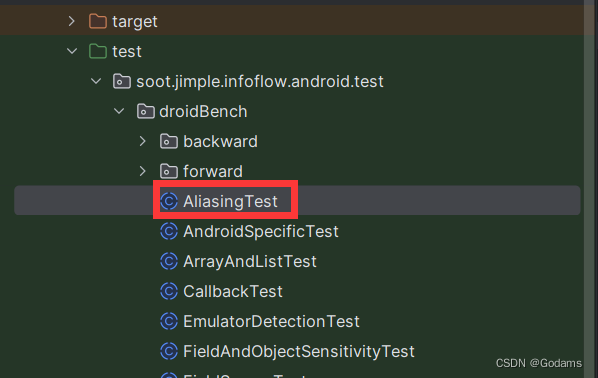
下面对AliasingTest进行案例分析
代码逻辑分析
analyzeAPKFile
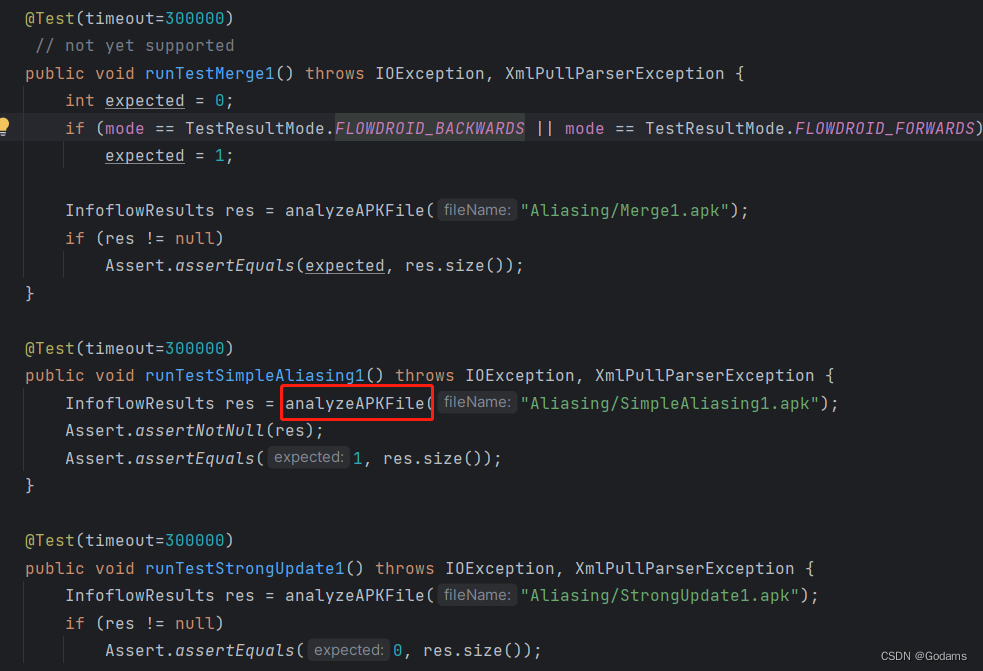
这部分跟进去是一个自定义的测试代码片段,跟进去看具体实现,可以看到不同的接口
ICC model(GPT4的回答):
在FlowDroid中,ICC(Inter-Component Communication,组件间通信)模型用于表示和处理安卓应用中各个组件(例如活动、服务、广播接收器等)之间如何相互通信。在Android中,组件通常通过Intent机制来相互通信。ICC模型旨在建模这种Intent传递机制,以更准确地进行数据流分析。
具体来说,FlowDroid的ICC模型可能包括以下几方面的信息:
- 哪个组件发送了Intent。
- Intent中包含哪些数据。
- Intent被发送到哪个组件。
- 如何处理接收到的Intent。
通过精确地建模这些交互,FlowDroid可以更准确地追踪可能的数据流路径,从而更有效地检测潜在的安全问题。该模型对于理解应用如何处理敏感数据,以及这些数据可能如何泄露(通过组件间的不安全通信)等问题非常有用。
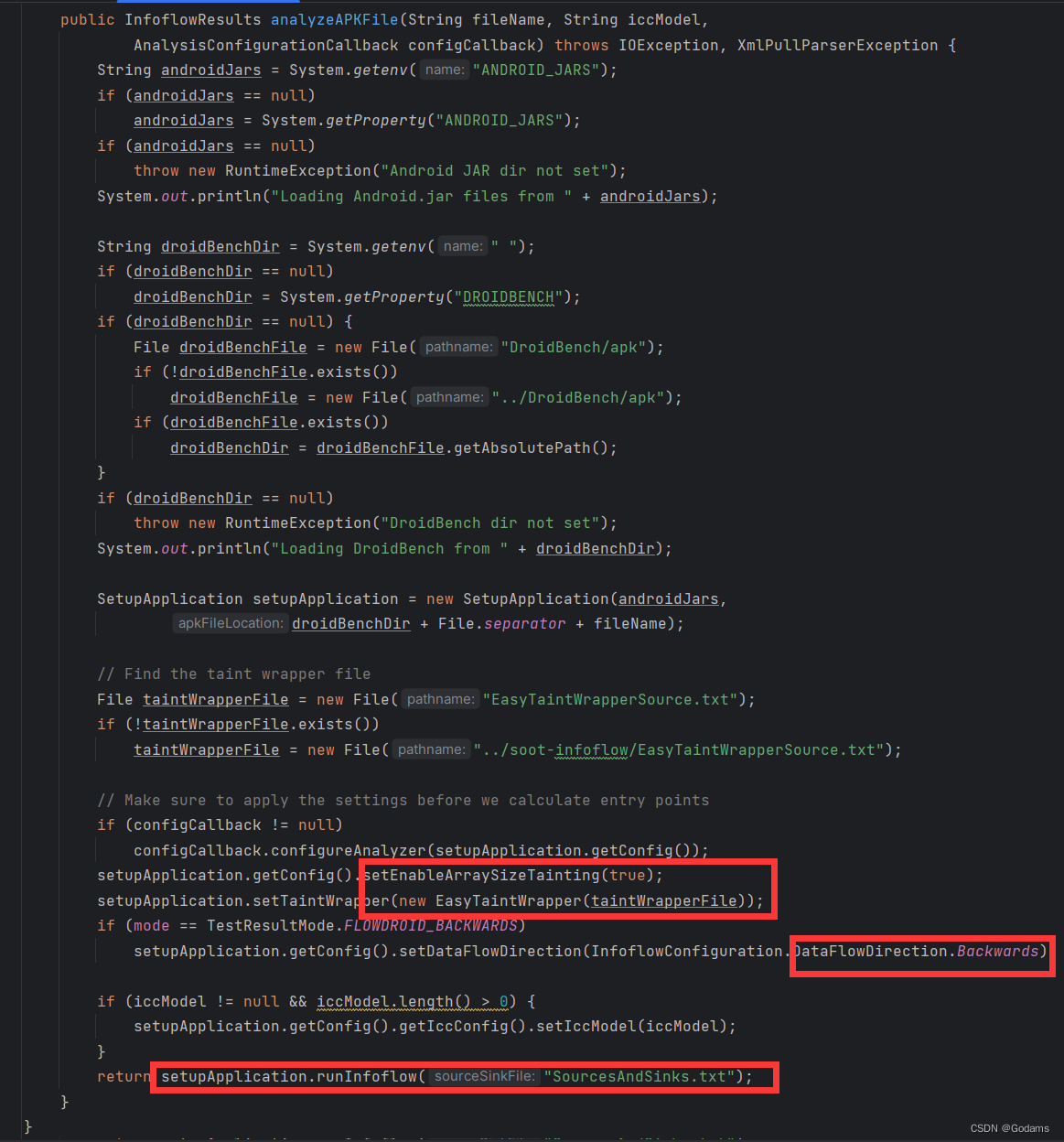
再往下跟就是一些配置信息,读取环境变量等,跟进runInfoflow函数,是比较关键的
runInfoflow
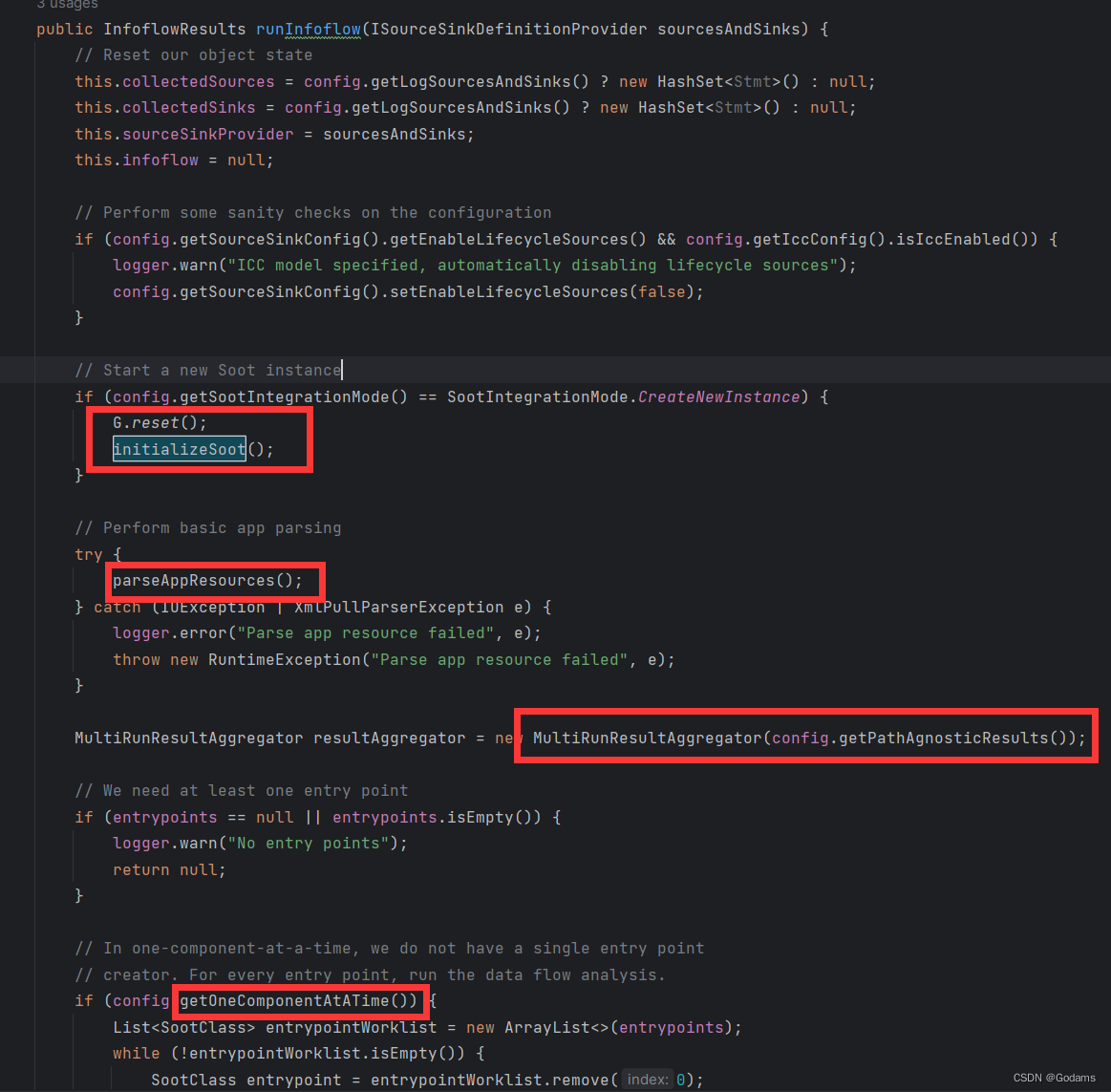
//这两行代码做了soot的初始化
if (config.getSootIntegrationMode() == SootIntegrationMode.CreateNewInstance) {G.reset();initializeSoot();
}
//soot初始化关键函数,比较常规
private void initializeSoot() {logger.info("Initializing Soot...");final String androidJar = config.getAnalysisFileConfig().getAndroidPlatformDir();final String apkFileLocation = config.getAnalysisFileConfig().getTargetAPKFile();// Clean up any old Soot instance we may haveG.reset();Options.v().set_no_bodies_for_excluded(true);Options.v().set_allow_phantom_refs(true);if (config.getWriteOutputFiles())Options.v().set_output_format(Options.output_format_jimple);elseOptions.v().set_output_format(Options.output_format_none);Options.v().set_whole_program(true);Options.v().set_process_dir(Collections.singletonList(apkFileLocation));if (forceAndroidJar)Options.v().set_force_android_jar(androidJar);elseOptions.v().set_android_jars(androidJar);Options.v().set_src_prec(Options.src_prec_apk_class_jimple);Options.v().set_keep_offset(false);Options.v().set_keep_line_number(config.getEnableLineNumbers());Options.v().set_throw_analysis(Options.throw_analysis_dalvik);Options.v().set_process_multiple_dex(config.getMergeDexFiles());Options.v().set_ignore_resolution_errors(true);// Set soot phase option if original names should be usedif (config.getEnableOriginalNames())Options.v().setPhaseOption("jb", "use-original-names:true");// Set the Soot configuration options. Note that this will needs to be// done before we compute the classpath.if (sootConfig != null)sootConfig.setSootOptions(Options.v(), config);Options.v().set_soot_classpath(getClasspath());Main.v().autoSetOptions();configureCallgraph();// Load whatever we needlogger.info("Loading dex files...");Scene.v().loadNecessaryClasses();// Make sure that we have valid Jimple bodiesPackManager.v().getPack("wjpp").apply();// Patch the callgraph to support additional edges. We do this now,// because during callback discovery, the context-insensitive callgraph// algorithm would flood us with invalid edges.LibraryClassPatcher patcher = getLibraryClassPatcher();patcher.patchLibraries();}
接下来对apk资源文件进行解析,分析入口点
try {parseAppResources();} catch (IOException | XmlPullParserException e) {logger.error("Parse app resource failed", e);throw new RuntimeException("Parse app resource failed", e);}
protected void parseAppResources() throws IOException, XmlPullParserException {final File targetAPK = new File(config.getAnalysisFileConfig().getTargetAPKFile());if (!targetAPK.exists())throw new RuntimeException(String.format("Target APK file %s does not exist", targetAPK.getCanonicalPath()));// Parse the resource filelong beforeARSC = System.nanoTime();this.resources = new ARSCFileParser();this.resources.parse(targetAPK.getAbsolutePath());logger.info("ARSC file parsing took " + (System.nanoTime() - beforeARSC) / 1E9 + " seconds");// To look for callbacks, we need to start somewhere. We use the Android// lifecycle methods for this purpose.this.manifest = createManifestParser(targetAPK);SystemClassHandler.v().setExcludeSystemComponents(config.getIgnoreFlowsInSystemPackages());Set<String> entryPoints = manifest.getEntryPointClasses();this.entrypoints = new HashSet<>(entryPoints.size());for (String className : entryPoints) {SootClass sc = Scene.v().getSootClassUnsafe(className);if (sc != null)this.entrypoints.add(sc);}}
processEntryPoint
Runs the data flow analysis on the given entry point class
if (config.getOneComponentAtATime()) {List<SootClass> entrypointWorklist = new ArrayList<>(entrypoints);while (!entrypointWorklist.isEmpty()) {SootClass entrypoint = entrypointWorklist.remove(0);processEntryPoint(sourcesAndSinks, resultAggregator, entrypointWorklist.size(), entrypoint);}} elseprocessEntryPoint(sourcesAndSinks, resultAggregator, -1, null);
resultAggregator 记录结果的地方
protected void processEntryPoint(ISourceSinkDefinitionProvider sourcesAndSinks,MultiRunResultAggregator resultAggregator, int numEntryPoints, SootClass entrypoint) {long beforeEntryPoint = System.nanoTime();// Get rid of leftovers from the last entry pointresultAggregator.clearLastResults();// Perform basic app parsinglong callbackDuration = System.nanoTime();try {if (config.getOneComponentAtATime())calculateCallbacks(sourcesAndSinks, entrypoint);elsecalculateCallbacks(sourcesAndSinks);} catch (IOException | XmlPullParserException e) {logger.error("Callgraph construction failed: " + e.getMessage(), e);throw new RuntimeException("Callgraph construction failed", e);}callbackDuration = Math.round((System.nanoTime() - callbackDuration) / 1E9);logger.info(String.format("Collecting callbacks and building a callgraph took %d seconds", (int) callbackDuration));final Collection<? extends ISourceSinkDefinition> sources = getSources();final Collection<? extends ISourceSinkDefinition> sinks = getSinks();final String apkFileLocation = config.getAnalysisFileConfig().getTargetAPKFile();if (config.getOneComponentAtATime())logger.info("Running data flow analysis on {} (component {}/{}: {}) with {} sources and {} sinks...",apkFileLocation, (entrypoints.size() - numEntryPoints), entrypoints.size(), entrypoint,sources == null ? 0 : sources.size(), sinks == null ? 0 : sinks.size());elselogger.info("Running data flow analysis on {} with {} sources and {} sinks...", apkFileLocation,sources == null ? 0 : sources.size(), sinks == null ? 0 : sinks.size());// Create a new entry point and compute the flows in it. If we// analyze all components together, we do not need a new callgraph,// but can reuse the one from the callback collection phase.if (config.getOneComponentAtATime() && config.getSootIntegrationMode().needsToBuildCallgraph()) {createMainMethod(entrypoint);constructCallgraphInternal();}// Create and run the data flow trackerinfoflow = createInfoflow();infoflow.addResultsAvailableHandler(resultAggregator);infoflow.runAnalysis(sourceSinkManager, entryPointCreator.getGeneratedMainMethod());// Update the statisticsif (config.getLogSourcesAndSinks() && infoflow.getCollectedSources() != null)this.collectedSources.addAll(infoflow.getCollectedSources());if (config.getLogSourcesAndSinks() && infoflow.getCollectedSinks() != null)this.collectedSinks.addAll(infoflow.getCollectedSinks());// Print out the found results{int resCount = resultAggregator.getLastResults() == null ? 0 : resultAggregator.getLastResults().size();if (config.getOneComponentAtATime())logger.info("Found {} leaks for component {}", resCount, entrypoint);elselogger.info("Found {} leaks", resCount);}// Update the performance object with the real data{InfoflowResults lastResults = resultAggregator.getLastResults();if (lastResults != null) {InfoflowPerformanceData perfData = lastResults.getPerformanceData();if (perfData == null)lastResults.setPerformanceData(perfData = new InfoflowPerformanceData());perfData.setCallgraphConstructionSeconds((int) callbackDuration);perfData.setTotalRuntimeSeconds((int) Math.round((System.nanoTime() - beforeEntryPoint) / 1E9));}}// We don't need the computed callbacks anymorethis.callbackMethods.clear();this.fragmentClasses.clear();// Notify our result handlersfor (ResultsAvailableHandler handler : resultsAvailableHandlers)handler.onResultsAvailable(resultAggregator.getLastICFG(), resultAggregator.getLastResults());}
calculateCallbacks(sourcesAndSinks)
传进来的参数即为读取的sources和sinks
Calculates the sets of sources, sinks, entry points, and callbacks methods
for the entry point in the given APK file.

private void calculateCallbacks(ISourceSinkDefinitionProvider sourcesAndSinks, SootClass entryPoint)throws IOException, XmlPullParserException {// Add the callback methodsLayoutFileParser lfp = null;final CallbackConfiguration callbackConfig = config.getCallbackConfig();if (callbackConfig.getEnableCallbacks()) {// If we have a callback file, we use itString callbackFile = callbackConfig.getCallbacksFile();if (callbackFile != null && !callbackFile.isEmpty()) {File cbFile = new File(callbackFile);if (cbFile.exists()) {CollectedCallbacks callbacks = CollectedCallbacksSerializer.deserialize(callbackConfig);if (callbacks != null) {// Get our callback data from the fileentrypoints = callbacks.getEntryPoints();fragmentClasses = callbacks.getFragmentClasses();callbackMethods = callbacks.getCallbackMethods();// Create the callgraphcreateMainMethod(entryPoint);constructCallgraphInternal();createSourceSinkProvider(entryPoint, lfp);return;}}}if (callbackClasses != null && callbackClasses.isEmpty()) {logger.warn("Callback definition file is empty, disabling callbacks");} else {lfp = createLayoutFileParser();switch (callbackConfig.getCallbackAnalyzer()) {case Fast:calculateCallbackMethodsFast(lfp, entryPoint);break;case Default:calculateCallbackMethods(lfp, entryPoint);break;default:throw new RuntimeException("Unknown callback analyzer");}}} else if (config.getSootIntegrationMode().needsToBuildCallgraph()) {// Create the new iteration of the main methodcreateMainMethod(entryPoint);constructCallgraphInternal();}logger.info("Entry point calculation done.");createSourceSinkProvider(entryPoint, lfp);}
在此过程中给对Layout进行了解析LayoutFileParser(this.manifest.getPackageName(), this.resources);
lfp = createLayoutFileParser();
calculateCallbackMethods(lfp, entryPoint);
下面这是真正的计算了
private void calculateCallbackMethods(LayoutFileParser lfp, SootClass component) throws IOException {final CallbackConfiguration callbackConfig = config.getCallbackConfig();// Load the APK fileif (config.getSootIntegrationMode().needsToBuildCallgraph())releaseCallgraph();// Make sure that we don't have any leftovers from previous runsPackManager.v().getPack("wjtp").remove("wjtp.lfp");PackManager.v().getPack("wjtp").remove("wjtp.ajc");// Get the classes for which to find callbacksSet<SootClass> entryPointClasses = getComponentsToAnalyze(component);// Collect the callback interfaces implemented in the app's// source code. Note that the filters should know all components to// filter out callbacks even if the respective component is only// analyzed later.AbstractCallbackAnalyzer jimpleClass = callbackClasses == null? new DefaultCallbackAnalyzer(config, entryPointClasses, callbackMethods, callbackFile): new DefaultCallbackAnalyzer(config, entryPointClasses, callbackMethods, callbackClasses);if (valueProvider != null)jimpleClass.setValueProvider(valueProvider);jimpleClass.addCallbackFilter(new AlienHostComponentFilter(entrypoints));jimpleClass.addCallbackFilter(new ApplicationCallbackFilter(entrypoints));jimpleClass.addCallbackFilter(new UnreachableConstructorFilter());jimpleClass.collectCallbackMethods();// Find the user-defined sources in the layout XML files. This// only needs to be done once, but is a Soot phase.lfp.parseLayoutFile(config.getAnalysisFileConfig().getTargetAPKFile());// Watch the callback collection algorithm's memory consumptionFlowDroidMemoryWatcher memoryWatcher = null;FlowDroidTimeoutWatcher timeoutWatcher = null;if (jimpleClass instanceof IMemoryBoundedSolver) {// Make sure that we don't spend too much time and memory in the callback// analysismemoryWatcher = createCallbackMemoryWatcher(jimpleClass);timeoutWatcher = createCallbackTimeoutWatcher(callbackConfig, jimpleClass);}try {int depthIdx = 0;boolean hasChanged = true;boolean isInitial = true;while (hasChanged) {hasChanged = false;// Check whether the solver has been aborted in the meantimeif (jimpleClass instanceof IMemoryBoundedSolver) {if (((IMemoryBoundedSolver) jimpleClass).isKilled())break;}// Create the new iteration of the main methodcreateMainMethod(component);int numPrevEdges = 0;if (Scene.v().hasCallGraph()) {numPrevEdges = Scene.v().getCallGraph().size();}// Since the generation of the main method can take some time,// we check again whether we need to stop.if (jimpleClass instanceof IMemoryBoundedSolver) {if (((IMemoryBoundedSolver) jimpleClass).isKilled()) {logger.warn("Callback calculation aborted due to timeout");break;}}if (!isInitial) {// Reset the callgraphreleaseCallgraph();// We only want to parse the layout files oncePackManager.v().getPack("wjtp").remove("wjtp.lfp");}isInitial = false;// Run the soot-based operationsconstructCallgraphInternal();if (!Scene.v().hasCallGraph())throw new RuntimeException("No callgraph in Scene even after creating one. That's very sad "+ "and should never happen.");lfp.parseLayoutFileDirect(config.getAnalysisFileConfig().getTargetAPKFile());PackManager.v().getPack("wjtp").apply();// Creating all callgraph takes time and memory. Check whether// the solver has been aborted in the meantimeif (jimpleClass instanceof IMemoryBoundedSolver) {if (((IMemoryBoundedSolver) jimpleClass).isKilled()) {logger.warn("Aborted callback collection because of low memory");break;}}if (numPrevEdges < Scene.v().getCallGraph().size())hasChanged = true;// Collect the results of the soot-based phasesif (this.callbackMethods.putAll(jimpleClass.getCallbackMethods()))hasChanged = true;if (entrypoints.addAll(jimpleClass.getDynamicManifestComponents()))hasChanged = true;// Collect the XML-based callback methodsif (collectXmlBasedCallbackMethods(lfp, jimpleClass))hasChanged = true;// Avoid callback overruns. If we are beyond the callback limit// for one entry point, we may not collect any further callbacks// for that entry point.if (callbackConfig.getMaxCallbacksPerComponent() > 0) {for (Iterator<SootClass> componentIt = this.callbackMethods.keySet().iterator(); componentIt.hasNext();) {SootClass callbackComponent = componentIt.next();if (this.callbackMethods.get(callbackComponent).size() > callbackConfig.getMaxCallbacksPerComponent()) {componentIt.remove();jimpleClass.excludeEntryPoint(callbackComponent);}}}// Check depth limitingdepthIdx++;if (callbackConfig.getMaxAnalysisCallbackDepth() > 0&& depthIdx >= callbackConfig.getMaxAnalysisCallbackDepth())break;// If we work with an existing callgraph, the callgraph never// changes and thus it doesn't make any sense to go multiple// roundsif (config.getSootIntegrationMode() == SootIntegrationMode.UseExistingCallgraph)break;}} catch (Exception ex) {logger.error("Could not calculate callback methods", ex);throw ex;} finally {// Shut down the watchersif (timeoutWatcher != null)timeoutWatcher.stop();if (memoryWatcher != null)memoryWatcher.close();}// Filter out callbacks that belong to fragments that are not used by// the host activityAlienFragmentFilter fragmentFilter = new AlienFragmentFilter(invertMap(fragmentClasses));fragmentFilter.reset();for (Iterator<Pair<SootClass, AndroidCallbackDefinition>> cbIt = this.callbackMethods.iterator(); cbIt.hasNext();) {Pair<SootClass, AndroidCallbackDefinition> pair = cbIt.next();// Check whether the filter accepts the given mappingif (!fragmentFilter.accepts(pair.getO1(), pair.getO2().getTargetMethod()))cbIt.remove();else if (!fragmentFilter.accepts(pair.getO1(), pair.getO2().getTargetMethod().getDeclaringClass())) {cbIt.remove();}}// Avoid callback overrunsif (callbackConfig.getMaxCallbacksPerComponent() > 0) {for (Iterator<SootClass> componentIt = this.callbackMethods.keySet().iterator(); componentIt.hasNext();) {SootClass callbackComponent = componentIt.next();if (this.callbackMethods.get(callbackComponent).size() > callbackConfig.getMaxCallbacksPerComponent())componentIt.remove();}}// Make sure that we don't retain any weird Soot phasesPackManager.v().getPack("wjtp").remove("wjtp.lfp");PackManager.v().getPack("wjtp").remove("wjtp.ajc");// Warn the user if we had to abort the callback analysis earlyboolean abortedEarly = false;if (jimpleClass instanceof IMemoryBoundedSolver) {if (((IMemoryBoundedSolver) jimpleClass).isKilled()) {logger.warn("Callback analysis aborted early due to time or memory exhaustion");abortedEarly = true;}}if (!abortedEarly)logger.info("Callback analysis terminated normally");// Serialize the callbacksif (callbackConfig.isSerializeCallbacks()) {CollectedCallbacks callbacks = new CollectedCallbacks(entryPointClasses, callbackMethods, fragmentClasses);CollectedCallbacksSerializer.serialize(callbacks, callbackConfig);}}
这段代码首先对调用图进行重置
protected void releaseCallgraph() {// If we are configured to use an existing callgraph, we may not release// itif (config.getSootIntegrationMode() == SootIntegrationMode.UseExistingCallgraph)return;Scene.v().releaseCallGraph();Scene.v().releasePointsToAnalysis();Scene.v().releaseReachableMethods();G.v().resetSpark();}
接下来两行代码不懂问了GPT
// Make sure that we don't have any leftovers from previous runsPackManager.v().getPack("wjtp").remove("wjtp.lfp");PackManager.v().getPack("wjtp").remove("wjtp.ajc");
PackManager.v().getPack("wjtp"):
这部分获取名为 “wjtp” 的分析阶段组(pack)。Soot框架将各种分析和转换任务组织在不同的阶段组(如 “wjtp”, “jtp”, “cg” 等)中。
remove(“wjtp.lfp”) 和 remove(“wjtp.ajc”):这两行代码从 “wjtp” 阶段组中移除特定的分析或转换阶段。具体来说,它们移除名为 “wjtp.lfp” 和 “wjtp.ajc” 的阶段。
这两行代码确保在新一轮的Soot分析或转换开始之前,清除先前可能添加到 “wjtp” 阶段组的 “wjtp.lfp” 和 “wjtp.ajc” 分析阶段。这样做主要是为了避免先前运行的残留影响到当前的运行。这是一种清理机制,确保每次运行都是在干净、一致的环境中进行。
再次回到processEntryPoint


Instantiates and configures the data flow engine
private IInPlaceInfoflow createInfoflow() {// Some sanity checksif (config.getSootIntegrationMode().needsToBuildCallgraph()) {if (entryPointCreator == null)throw new RuntimeException("No entry point available");if (entryPointCreator.getComponentToEntryPointInfo() == null)throw new RuntimeException("No information about component entry points available");}// Get the component lifecycle methodsCollection<SootMethod> lifecycleMethods = Collections.emptySet();if (entryPointCreator != null) {ComponentEntryPointCollection entryPoints = entryPointCreator.getComponentToEntryPointInfo();if (entryPoints != null)lifecycleMethods = entryPoints.getLifecycleMethods();}// Initialize and configure the data flow trackerIInPlaceInfoflow info = createInfoflowInternal(lifecycleMethods);if (ipcManager != null)info.setIPCManager(ipcManager);info.setConfig(config);info.setSootConfig(sootConfig);info.setTaintWrapper(taintWrapper);info.setTaintPropagationHandler(taintPropagationHandler);info.setAliasPropagationHandler(aliasPropagationHandler);// We use a specialized memory manager that knows about Androidinfo.setMemoryManagerFactory(new IMemoryManagerFactory() {@Overridepublic IMemoryManager<Abstraction, Unit> getMemoryManager(boolean tracingEnabled,PathDataErasureMode erasePathData) {return new AndroidMemoryManager(tracingEnabled, erasePathData, entrypoints);}});info.setMemoryManagerFactory(null);// Inject additional post-processorsinfo.setPostProcessors(Collections.singleton(new PostAnalysisHandler() {@Overridepublic InfoflowResults onResultsAvailable(InfoflowResults results, IInfoflowCFG cfg) {// Purify the ICC results if requestedfinal IccConfiguration iccConfig = config.getIccConfig();if (iccConfig.isIccResultsPurifyEnabled()) {// no-op at the moment. We used to have a purifier here, but it didn't make// any sense. Removed it for the better.}return results;}}));return info;}
接下来进入到runAnalysis函数内部,这个函数似乎比较关键
Conducts a taint analysis on an already initialized callgraph
protected void runAnalysis(final ISourceSinkManager sourcesSinks, final Set<String> additionalSeeds) {final InfoflowPerformanceData performanceData = createPerformanceDataClass();try {// Clear the data from previous runsresults = createResultsObject();results.setPerformanceData(performanceData);// Print and check our configurationcheckAndFixConfiguration();config.printSummary();// Register a memory watcherif (memoryWatcher != null) {memoryWatcher.clearSolvers();memoryWatcher = null;}memoryWatcher = new FlowDroidMemoryWatcher(results, config.getMemoryThreshold());// Initialize the abstraction configurationAbstraction.initialize(config);// Build the callgraphlong beforeCallgraph = System.nanoTime();constructCallgraph();performanceData.setCallgraphConstructionSeconds((int) Math.round((System.nanoTime() - beforeCallgraph) / 1E9));logger.info(String.format(Locale.getDefault(), "Callgraph construction took %d seconds",performanceData.getCallgraphConstructionSeconds()));// Initialize the source sink managerif (sourcesSinks != null)sourcesSinks.initialize();// Perform constant propagation and remove dead codeif (config.getCodeEliminationMode() != CodeEliminationMode.NoCodeElimination) {long currentMillis = System.nanoTime();eliminateDeadCode(sourcesSinks);logger.info("Dead code elimination took " + (System.nanoTime() - currentMillis) / 1E9 + " seconds");}// After constant value propagation, we might find more call edges// for reflective method callsif (config.getEnableReflection()) {releaseCallgraph();constructCallgraph();}if (config.getCallgraphAlgorithm() != CallgraphAlgorithm.OnDemand)logger.info("Callgraph has {} edges", Scene.v().getCallGraph().size());IInfoflowCFG iCfg = icfgFactory.buildBiDirICFG(config.getCallgraphAlgorithm(),config.getEnableExceptionTracking());if (config.isTaintAnalysisEnabled())runTaintAnalysis(sourcesSinks, additionalSeeds, iCfg, performanceData);// Gather performance dataperformanceData.setTotalRuntimeSeconds((int) Math.round((System.nanoTime() - beforeCallgraph) / 1E9));performanceData.updateMaxMemoryConsumption(getUsedMemory());logger.info(String.format("Data flow solver took %d seconds. Maximum memory consumption: %d MB",performanceData.getTotalRuntimeSeconds(), performanceData.getMaxMemoryConsumption()));// Provide the handler with the final resultsfor (ResultsAvailableHandler handler : onResultsAvailable)handler.onResultsAvailable(iCfg, results);// Write the Jimple files to disk if requestedif (config.getWriteOutputFiles())PackManager.v().writeOutput();} catch (Exception ex) {StringWriter stacktrace = new StringWriter();PrintWriter pw = new PrintWriter(stacktrace);ex.printStackTrace(pw);if (results != null)results.addException(ex.getClass().getName() + ": " + ex.getMessage() + "\n" + stacktrace.toString());logger.error("Exception during data flow analysis", ex);if (throwExceptions)throw ex;}}
constructCallgraph();
构造调用图
protected void constructCallgraph() {if (config.getSootIntegrationMode().needsToBuildCallgraph()) {// Allow the ICC manager to change the Soot Scene before we continueif (ipcManager != null)ipcManager.updateJimpleForICC();// Run the preprocessorsfor (PreAnalysisHandler tr : preProcessors)tr.onBeforeCallgraphConstruction();// Patch the system libraries we need for callgraph constructionLibraryClassPatcher patcher = getLibraryClassPatcher();patcher.patchLibraries();// To cope with broken APK files, we convert all classes that are still// dangling after resolution into phantomsfor (SootClass sc : Scene.v().getClasses())if (sc.resolvingLevel() == SootClass.DANGLING) {sc.setResolvingLevel(SootClass.BODIES);sc.setPhantomClass();}// We explicitly select the packs we want to run for performance// reasons. Do not re-run the callgraph algorithm if the host// application already provides us with a CG.if (config.getCallgraphAlgorithm() != CallgraphAlgorithm.OnDemand && !Scene.v().hasCallGraph()) {PackManager.v().getPack("wjpp").apply();PackManager.v().getPack("cg").apply();}}// If we don't have a FastHierarchy, we need to create it - even if we use an// existing callgraphhierarchy = Scene.v().getOrMakeFastHierarchy();if (config.getSootIntegrationMode().needsToBuildCallgraph()) {// Run the preprocessorsfor (PreAnalysisHandler tr : preProcessors)tr.onAfterCallgraphConstruction();}}
runAnalysis分析结束后回到了processEntryPoint
相关文章:

【FlowDroid】一、处理流程学习
FlowDroid 一、处理流程学习 下载配置源码概况代码逻辑分析analyzeAPKFilerunInfoflowprocessEntryPointcalculateCallbacks(sourcesAndSinks)再次回到processEntryPoint 自己做一些笔记 下载配置 参照我前面的文章可以使用FlowDroid安装初体验 为了看代码了解FlowDroid如何处…...

MyBatis——MyBatis插件原理
摘要 本博文主要介绍MyBatis插件机原理,帮助大家更好的理解和学习MyBatis。 一、插件机制概述 MyBatis 允许你在已映射语句执行过程中的某一点进行拦截调用。默认情况下,MyBatis允许使用插件来拦截的方法调用包括: Executor (update, que…...
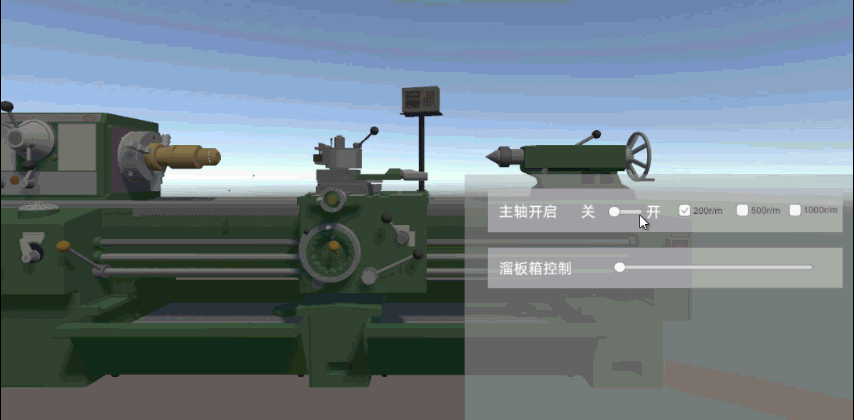
简易虚拟培训系统-UI控件的应用5
目录 Toggle控件简介 示例-使用Toggle组实现主轴速度选择 本篇介绍UI控件Toggle,尝试一个小示例-使用单选框实现速度的选择控制。 Toggle控件简介 1. Toggle的结构如下:最重要的Toggle组件挂在Toggle节点上,下面的Image组件用于显示单选框…...
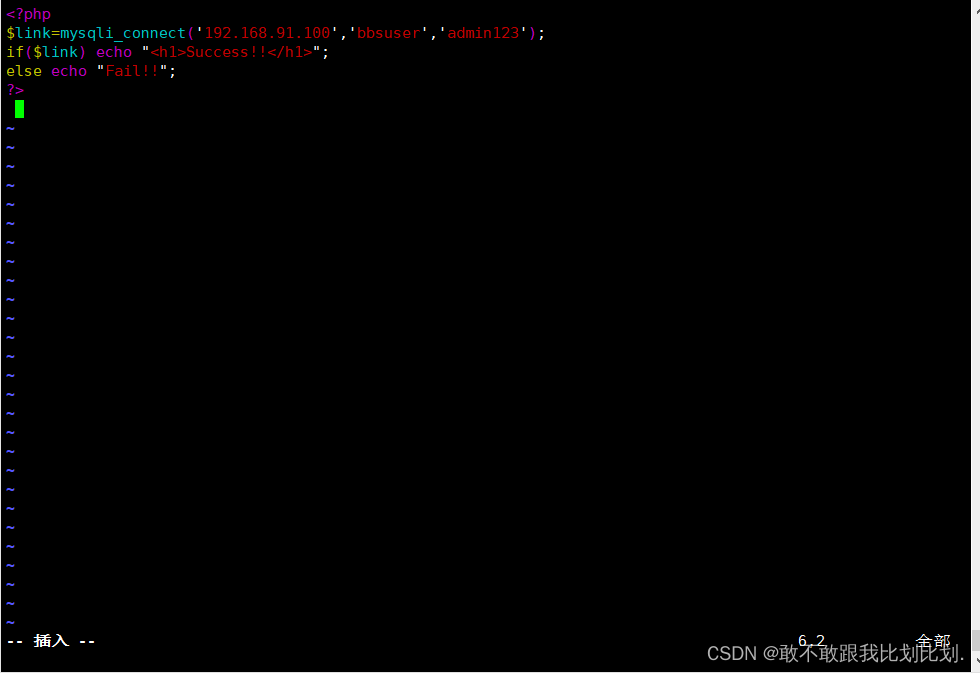
Lnmp架构
关闭防火墙 安装依赖包 yum -y install pcre-devel zlib-devel gcc gcc-c make 创建运行用户、组 编译安装Nginx 让系统识别nginx的操作命令 添加Nginx系统服务 vim /lib/systemd/system/nginx.service 编译安装mysql 安装Mysql环境依赖包 创建运行用户 编译安装 cd /opt …...

es5的实例__proto__(原型链) prototype(原型对象) {constructor:构造函数}
现在看这张图开始变得云里雾里,所以简单回顾一下 prototype 的基本内容,能够基本读懂这张图的脉络。 先介绍一个基本概念: function Person() {}Person.prototype.name KK;let person1 new Person();在上面的例子中, Person …...

Oracle DBlink使用方法
DBlink作用:在当前数据库中访问另一个数据库中的表中的数据 create public database link dblink名称 connect to 对方数据库用户名 identified by 对方数据库用户密码 using (DESCRIPTION (ADDRESS_LIST (ADDRESS (PROTOCOL TCP)(HOST 要连接的数据库所在服务…...
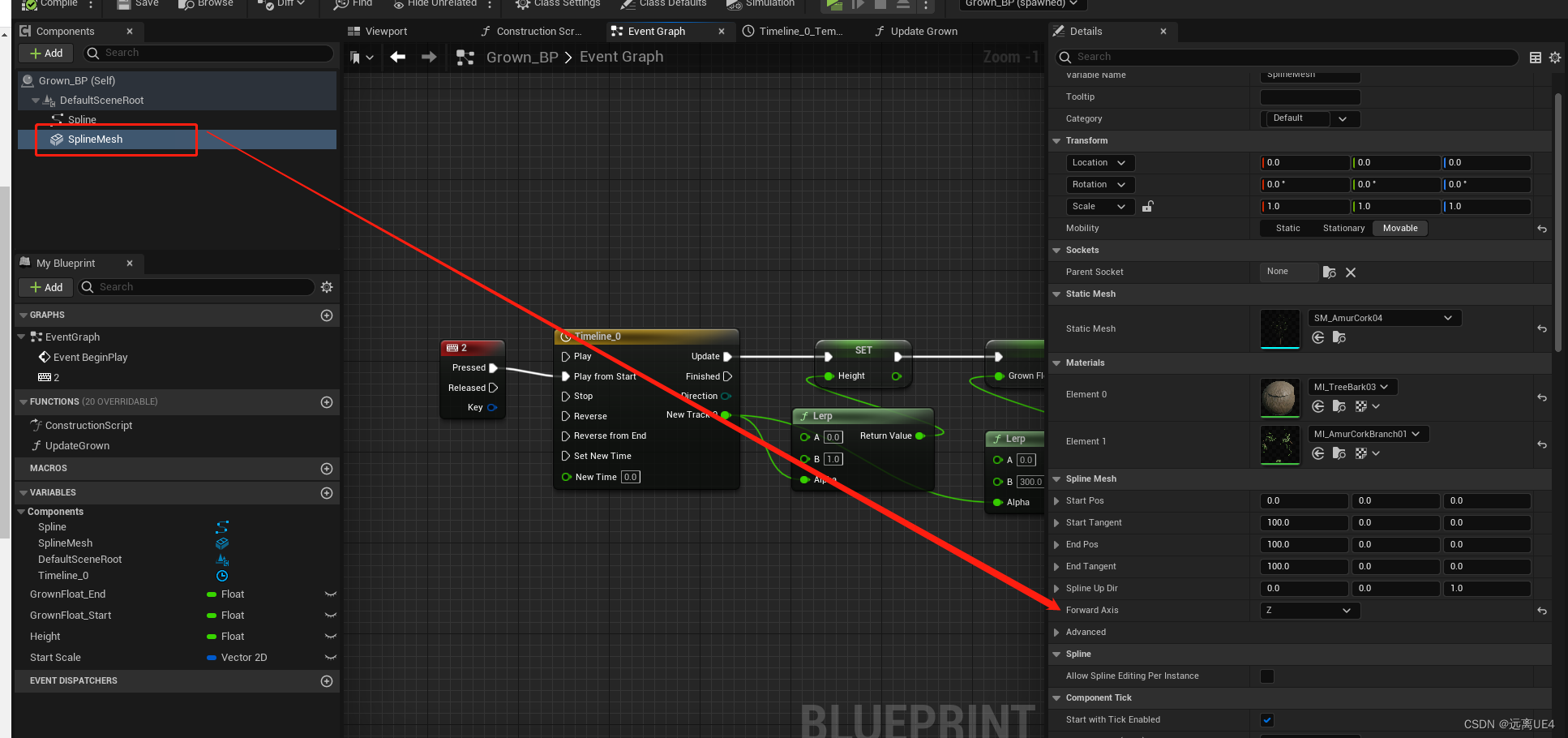
UE4 植物生长
这个可以改变SplineMesh朝向...

企业应用系统 PHP项目支持管理系统Dreamweaver开发mysql数据库web结构php编程计算机网页
一、源码特点 PHP 项目支持管理系统是一套完善的web设计系统 应用于企业项目管理,从企业内部的各个业务环境总体掌握,系统具有完整的源代码和数据库,系统主要采用B/S模式开发。 php项目支撑管理系统2 二、功能介绍 (1)权限管理࿱…...
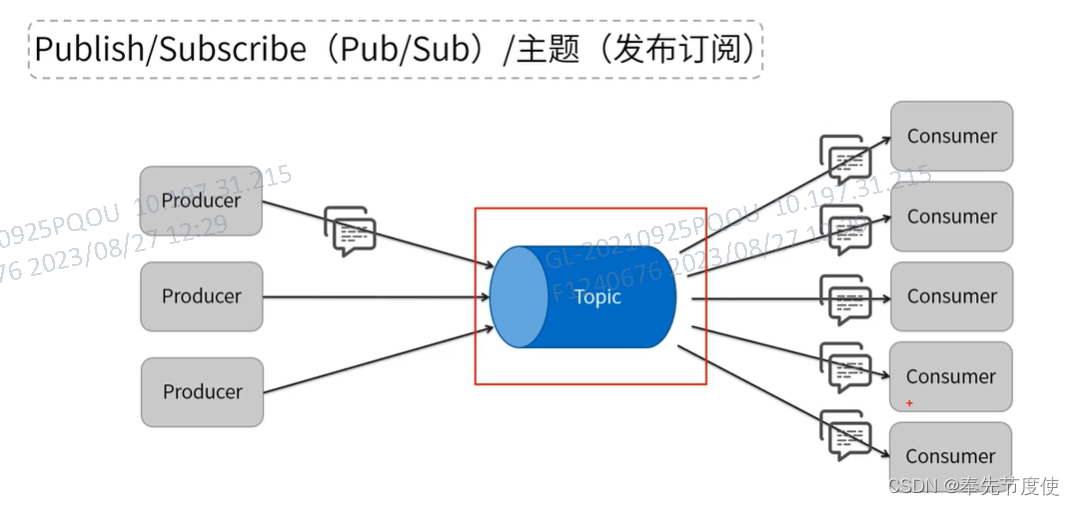
微服务通信[HTTP|RPC同步通信、MQ异步通信]
概念 A服务调用B服务,B服务调C服务,C服务调D服务,即微服务之间的通信(也可以叫微服务之间的调用) HTTP同步通信 一种轻量级的通信协议,常用于在不同的微服务之间进行通信,也是最简单的通信方式使用REST ful为开发规范,将服务对外暴露的HTTP调用方式为REST API(如GET…...

C语言模拟最简单的计算机
C语言模拟最简单的计算机 以下内容参考南大“计算机系统基础”实验:不停计算的机器 概述 如下面的伪代码所示,计算机运行程序的过程为取指令–>运行指令–>更新PC的值。 while (1) {从PC指示的存储器位置取出指令;执行指令;更新PC; }取指(inst…...

c++图论免费ppt,简单深度理解图论
本篇博文想分享一个ppt,是帮助大家简单深度理解c图论. 作者承诺:分享的东西没有病毒,是资料。 分享的东西一个是ppt,ppt里面是150页的,里面将带领大家简单深度理解c图论,还有一个就是里面例题的数据,大家可以按照数据…...

xml中in的使用
目录 一、简介 二、使用 1、参数为list 2、参数为Array 3、参数为Map XML中大于、小于、不等于符号使用 一、简介 在xml中使用in查询需要使用foreach标签 <foreach item"item" collection"list" index"index" open"(" sep…...

Unity生命周期函数
1、Awake 当对象(自己这个类对象,就是这个脚本)被创建时 才会调用该生命周期函数 类似构造函数的存在 我们可以在一个类对象创建时进行一些初始化操作 2、OnEnable 失活激活(这个勾) 想要当一个对象(游戏…...
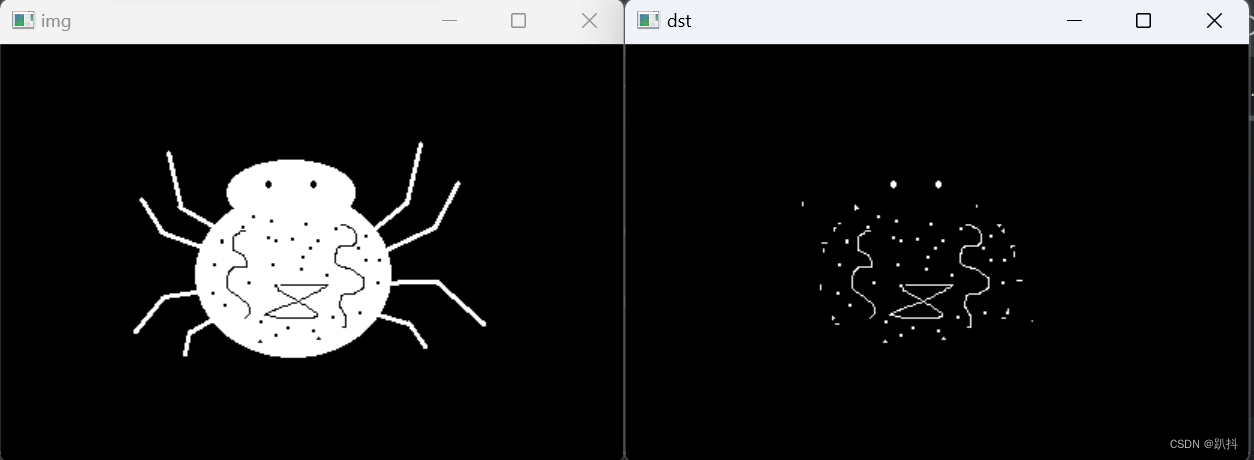
【OpenCV入门】第六部分——腐蚀与膨胀
文章结构 腐蚀膨胀开运算闭运算形态学方法梯度运算顶帽运算黑帽运算 腐蚀 腐蚀操作可以让图像沿着自己的边界向内收缩。OpenCV通过”核“来实现收缩计算。“核”在形态学中可以理解为”由n个像素组成的像素块“,像素块包含一个核心(通常在中央位置&…...
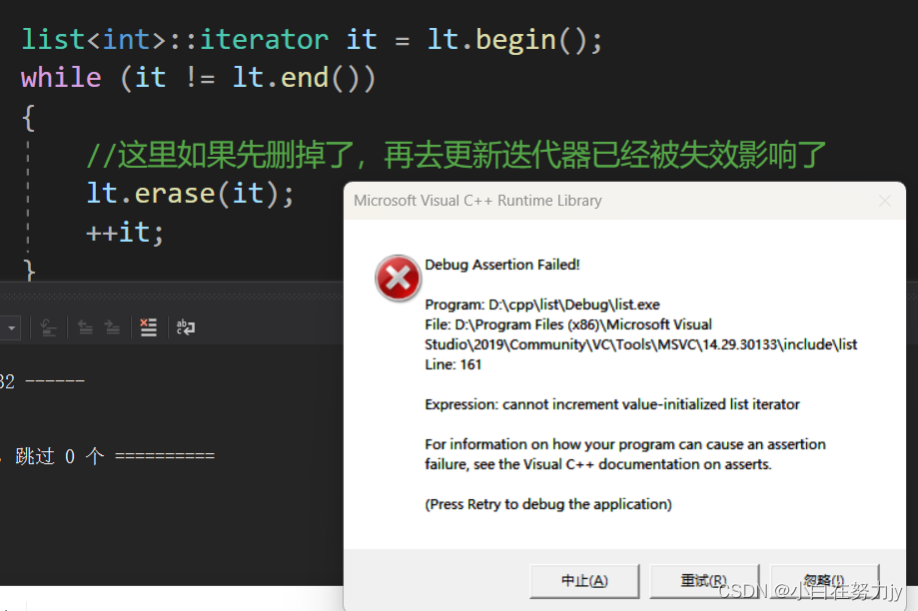
[C++] STL_list常用接口的模拟实现
文章目录 1、list的介绍与使用1.1 list的介绍1.2 list的使用 2、list迭代器3、list的构造4、list常用接口的实现4.1 list capacity4.2 插入删除、交换、清理4.2.1 insert任意位置插入4.2.2 push_front头插4.2.3 push_back尾插4.2.4 erase任意位置删除4.2.5 pop_front头删4.2.6 …...
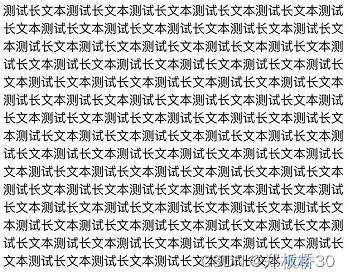
js实现点击查看全部/收起功能
在上一篇文章实现用js截取文本后,我的另一个需求也迎刃而解了。需求就是一段长文本需要溢出隐藏,然后点击全部时显示全部文本,点击收起又回到溢出隐藏的状态。实现的效果如下图: 实现的思路时点击全部时使用这条数据的原文本&…...

安全区域边界技术测评要求项
1.边界防护-非授权设备接入、非授权连接外部网络、无线网络使用和设备可信接入 (网络边界就是采用不同安全策略的两个网络的连接处) 1-1/2-1/3-4/4-6 a)保证跨越边界的访问和数据流通过边界设备提供的受控接口进行通信 b)应能够对…...

基于YOLOV8模型的农作机器和行人目标检测系统(PyTorch+Pyside6+YOLOv8模型)
摘要:基于YOLOV8模型的农作机器和行人目标检测系统可用于日常生活中检测与定位农作机和行人目标,利用深度学习算法可实现图片、视频、摄像头等方式的目标检测,另外本系统还支持图片、视频等格式的结果可视化与结果导出。本系统采用YOLOv8目标…...
)
我的私人笔记(安装hbase)
在安装前需要安装好JDK、Hadoop以及Zookeeper,JDK版本为1.8、Hadoop版本为2.7.4以及Zookeeper的版本为3.4.10。 4.1.下载 下载地址:Index of /dist/hbase 本次学习版本为: hbase-1.2.1-bin.tar.gz 4.2.安装步骤 上传安装包至hadoop01节点…...

【MySQL】用户管理
之前我们一直都使用root身份来对mysql进行操作,但这样存在安全隐患。这时,就需要使用MySQL的用户管理 目录 一、用户 1.1 用户信息 1.2 添加用户 1.3 删除用户 1.4 修改用户密码 二、用户权限 2.1 赋予授权 2.2 回收权限 一、用户 1.1 用户信息…...
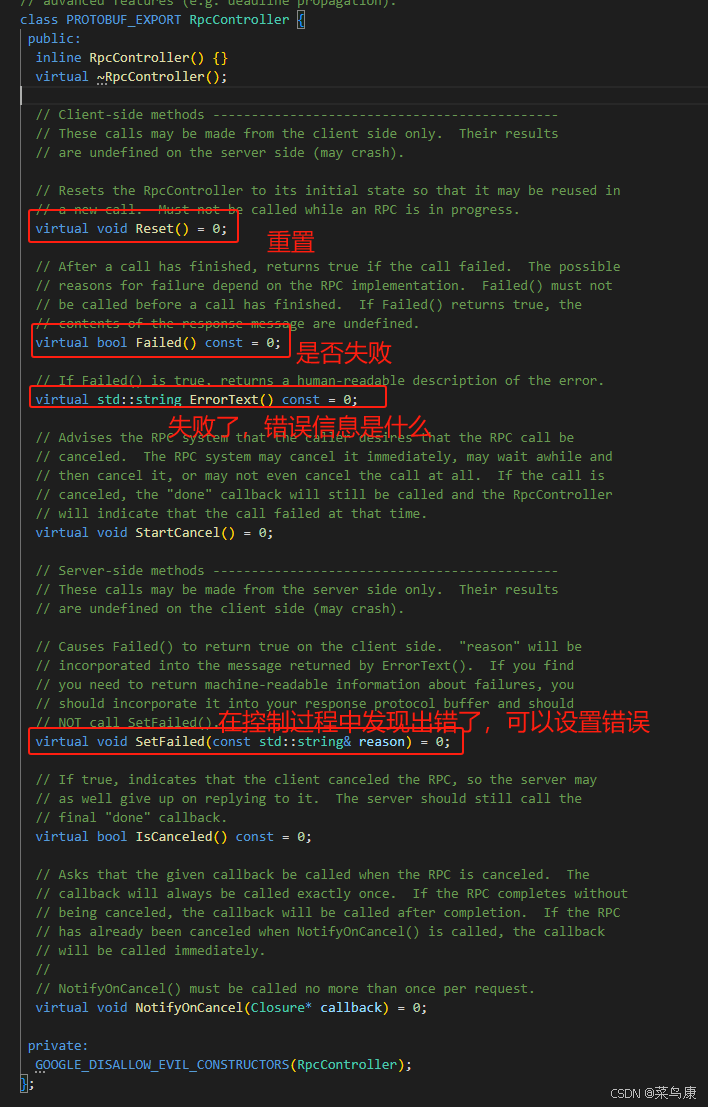
C++实现分布式网络通信框架RPC(3)--rpc调用端
目录 一、前言 二、UserServiceRpc_Stub 三、 CallMethod方法的重写 头文件 实现 四、rpc调用端的调用 实现 五、 google::protobuf::RpcController *controller 头文件 实现 六、总结 一、前言 在前边的文章中,我们已经大致实现了rpc服务端的各项功能代…...
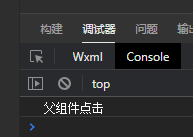
微信小程序之bind和catch
这两个呢,都是绑定事件用的,具体使用有些小区别。 官方文档: 事件冒泡处理不同 bind:绑定的事件会向上冒泡,即触发当前组件的事件后,还会继续触发父组件的相同事件。例如,有一个子视图绑定了b…...

DeepSeek 赋能智慧能源:微电网优化调度的智能革新路径
目录 一、智慧能源微电网优化调度概述1.1 智慧能源微电网概念1.2 优化调度的重要性1.3 目前面临的挑战 二、DeepSeek 技术探秘2.1 DeepSeek 技术原理2.2 DeepSeek 独特优势2.3 DeepSeek 在 AI 领域地位 三、DeepSeek 在微电网优化调度中的应用剖析3.1 数据处理与分析3.2 预测与…...
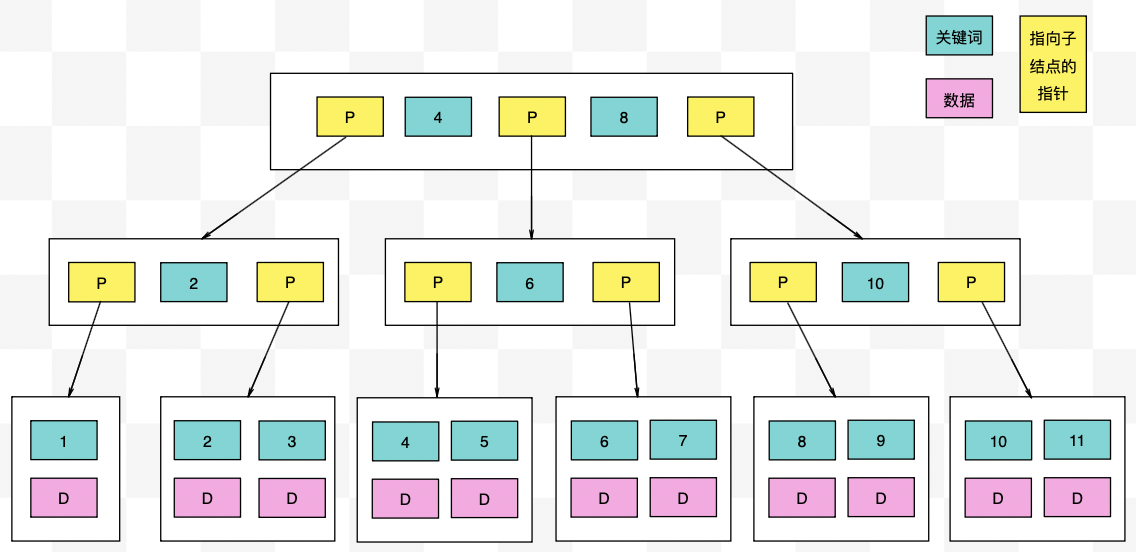
【力扣数据库知识手册笔记】索引
索引 索引的优缺点 优点1. 通过创建唯一性索引,可以保证数据库表中每一行数据的唯一性。2. 可以加快数据的检索速度(创建索引的主要原因)。3. 可以加速表和表之间的连接,实现数据的参考完整性。4. 可以在查询过程中,…...

【Linux】C语言执行shell指令
在C语言中执行Shell指令 在C语言中,有几种方法可以执行Shell指令: 1. 使用system()函数 这是最简单的方法,包含在stdlib.h头文件中: #include <stdlib.h>int main() {system("ls -l"); // 执行ls -l命令retu…...
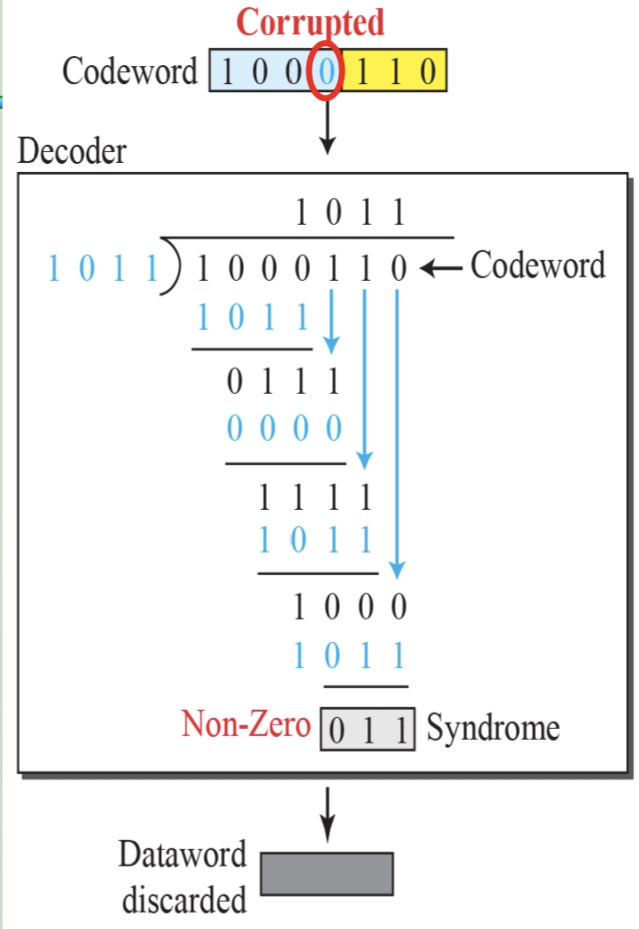
循环冗余码校验CRC码 算法步骤+详细实例计算
通信过程:(白话解释) 我们将原始待发送的消息称为 M M M,依据发送接收消息双方约定的生成多项式 G ( x ) G(x) G(x)(意思就是 G ( x ) G(x) G(x) 是已知的)࿰…...
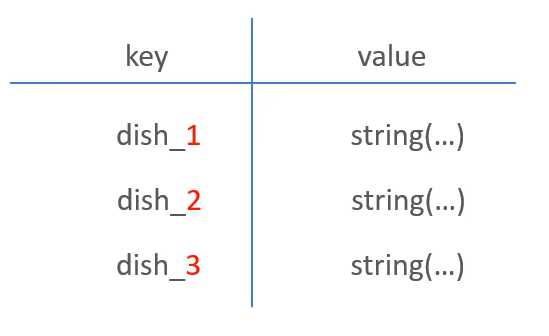
苍穹外卖--缓存菜品
1.问题说明 用户端小程序展示的菜品数据都是通过查询数据库获得,如果用户端访问量比较大,数据库访问压力随之增大 2.实现思路 通过Redis来缓存菜品数据,减少数据库查询操作。 缓存逻辑分析: ①每个分类下的菜品保持一份缓存数据…...

基于matlab策略迭代和值迭代法的动态规划
经典的基于策略迭代和值迭代法的动态规划matlab代码,实现机器人的最优运输 Dynamic-Programming-master/Environment.pdf , 104724 Dynamic-Programming-master/README.md , 506 Dynamic-Programming-master/generalizedPolicyIteration.m , 1970 Dynamic-Programm…...
中的KV缓存压缩与动态稀疏注意力机制设计)
大语言模型(LLM)中的KV缓存压缩与动态稀疏注意力机制设计
随着大语言模型(LLM)参数规模的增长,推理阶段的内存占用和计算复杂度成为核心挑战。传统注意力机制的计算复杂度随序列长度呈二次方增长,而KV缓存的内存消耗可能高达数十GB(例如Llama2-7B处理100K token时需50GB内存&a…...
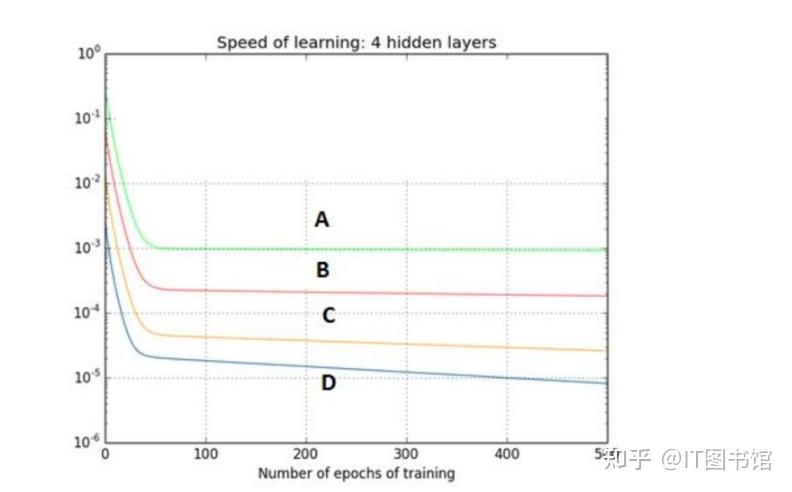
深度学习习题2
1.如果增加神经网络的宽度,精确度会增加到一个特定阈值后,便开始降低。造成这一现象的可能原因是什么? A、即使增加卷积核的数量,只有少部分的核会被用作预测 B、当卷积核数量增加时,神经网络的预测能力会降低 C、当卷…...
